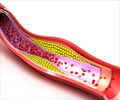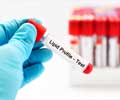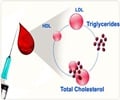Scientists from the Harvard School of Public Health (HSPH) claim to have paved the way for new therapies for lowering unhealthy blood levels of cholesterol and fats, by discovering
The discovery of an unknown molecule that regulates fat and cholesterol in the liver of mice may pave the way for new cholesterol reduction therapies, scientists from the Harvard School of Public Health (HSPH) have claimed.
In an animal model, the team showed that turning off the regulatory molecule, known as XBP1, significantly reduced blood levels of cholesterol and triglyceride fats. Importantly, there were no apparent adverse effects on the liver."XBP1 may be an attractive drug target for treating dyslipidemias [excess fats in the blood]," said Laurie Glimcher, professor of immunology in the Department of Immunology and Infectious Diseases at HSPH.
She said she and her colleagues are working with collaborators at the Broad Institute of MIT and Harvard to explore strategies for inhibiting XBP1 activity that could be applicable to humans.
"A key finding is that the liver in the mice lacking XBP1 seems to be perfectly normal, with minor effect on normal protein synthesis. It is a very selective effect in lowering cholesterol and triglyceride production," she added.
The researchers discovered that XBP1, a transcription factor that governs gene expression, is activated by the ingestion of a high carbohydrate diet. XBP1 then turns on genes for enzymes that cause the liver to manufacture fat and fat-like substances, which are transported in the blood to fat tissue for storage.
Excess amounts of these compounds, cholesterol and triglycerides, in the bloodstream can be dangerous, leading to heart disease and increased risk of strokes.
Advertisement
The molecule had been discovered by Glimcher two decades ago when she was searching for regulators of genes in the Major Histocompatiblity Complex, or MHC, a group of proteins that enables the immune system to distinguish between "self" and foreign substances in the body.
Advertisement
To unravel the role of XBP1 in the adult liver, Lee and colleagues developed a mouse model in which XBP1 functioned normally during fetal development but could be inactivated at will in the adult. To their surprise, the researchers found that knocking out XBP1 in adult rodents had no obvious abnormalities -- nor was there any evidence of damage to the liver.
What they did observe, however, was a dramatic decrease of cholesterol, triglycerides and free fatty acids in the XBP1-knockout mice compared with normal controls.
oreover, the lack of XBP1 almost entirely eliminated the "bad" LDL cholesterol in the bloodstream. Concerned that the triglycerides might be accumulating in the liver instead -- a condition in humans called "fatty liver" -- the researchers found this was not the case, indicating that the manufacture of triglycerides in the liver was shut down.
When individuals eat excess carbohydrates, their bodies convert surplus carbohydrates into triglycerides to store them in fat tissue, which may be used as an energy source when food intake is limited. This lipid synthesis process occurs in the liver and is dynamically controlled depending on nutritional condition. XBP1, activated by a high-carbohydrate diet that strongly promotes lipid synthesis in the liver, induces several critical enzymes governing this process.
The Glimcher team concluded that XBP1 has a distinct role in generating lipids in the liver when stimulated by a high-carbohydrate diet and that this role is not connected in any way with its function as a regulator of the unfolded protein response. Because XBP1 acts in such a selective way on the liver's lipid-making mechanism, the researchers are eager to determine whether drugs targeted to the molecule have a future in treating individuals with high blood levels of triglycerides and cholesterol.
Elevated levels of triglycerides and LDL cholesterol are key features of metabolic syndrome, which confers high risk of type 2 diabetes and atherosclerosis. The widely used drugs known as statins reduce blood cholesterol by inhibiting a key enzyme for its synthesis in the liver; they lower the risk of atherosclerosis.
It appears that XBP1 controls the biosynthesis pathways for both triglycerides and cholesterol. The researchers hope that compounds that block the XBP1 pathway could lower both triglycerides and cholesterol and thereby help prevent diabetes and atherosclerosis.
"We don't yet know whether blocking the XBP1 pathway will be better than the statins, which are very good drugs but have side effects like all drugs do. But it is a different pathway," Glimcher said.
The study is published in the June 13, 2008 issue of Science.
Source-ANI
RAS/M











